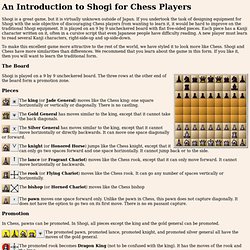

Hans Geuns' Basic Shogi vocabulary. Main Page - Shogipedia. Shogi. Shogi is a great game, but it is virtually unknown outside of Japan.

If you undertook the task of designing equipment for Shogi with the sole objective of discouraging Chess players from wanting to learn it, it would be hard to improve on the traditional Shogi equipment. It is played on an 9 by 9 uncheckered board with flat five-sided pieces. Each piece has a Kanji character written on it, often in a cursive script that even Japanese people have difficulty reading. A new player must learn to read several Kanji characters, right-side-up and up-side-down.
To make this excellent game more attractive to the rest of the world, we have styled it to look more like Chess. The Board Shogi is played on a 9 by 9 uncheckered board. Pieces The king (or Jade General) moves like the Chess king: one square horizontally or vertically or diagonally. The Gold General has moves similar to the king, except that it cannot take the back diagonals. The rook (or Flying Chariot) moves like the Chess rook. Promotion. Shogi: Japanese Chess (the Chess Variant Pages)
Japanese Chess Shogi is recognized as a CLASSIC Chess variant, distinguished for its immense popularity and rich history.

It has been featured at the top of our pages in February 2002 and January 2011. Introduction Shogi is the Japanese cousin of Chess. It is very similar to Chess in some respects, differing from it mainly by allowing players to keep captured pieces and replay them as their own. The similarites between Chess and Shogi suggest a common origin, and it is commonly held that their common origin was a game called Chaturanga, which arose in India in approximately the 7th century AD. (shô ) (-gi) Shô means general and Gi means board game. Perhaps the enduring popularity of Shogi can be attributed to its 'drop rule'; it was the first chess variant wherein captured pieces could be returned to the board to be used as one's own. Setup Shogi is played on a 9x9 board. Shogi begins in the position shown below in either of the two diagrams. Traditional board, pieces, and notation Pieces. Shogi. Shogi (将棋, shōgi?) (/ˈʃoʊɡiː/, Japanese: [ɕo̞ːɡi] or [ɕo̞ːŋi]), also known as Japanese chess or the Generals' Game, is a two-player strategy board game in the same family as Western (international) chess, chaturanga, makruk, shatranj and xiangqi, and is the most popular of a family of chess variants native to Japan.
Shōgi means general's (shō 将) board game (gi 棋). The earliest predecessor of the game, chaturanga, originated in India in the 6th century, and sometime in the 10th to 12th centuries xiangqi (Chinese chess) was brought to Japan where it spawned a number of variants. Shogi in its present form was played as early as the 16th century, while a direct ancestor without the "drop rule" was recorded from 1210 in a historical document Nichūreki, which is an edited copy of Shōchūreki and Kaichūreki from the late Heian period (c. 1120). According to The Chess Variant Pages :[1] Game equipment[edit] A traditional shōgi-ban (shogi board) displaying a set of koma (pieces).
Or 6. lances 8. rook.